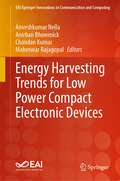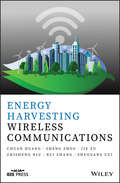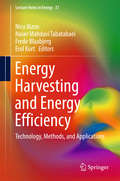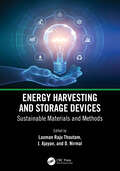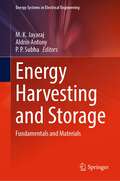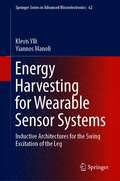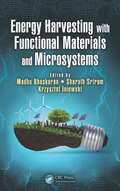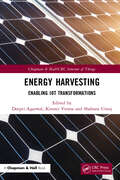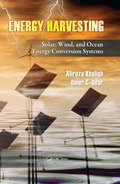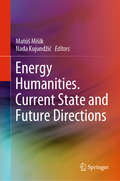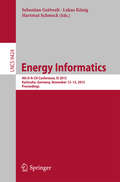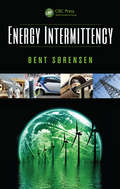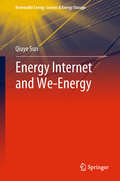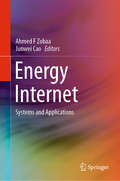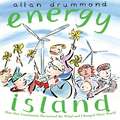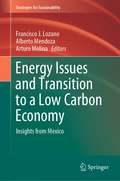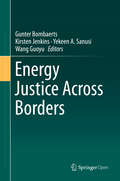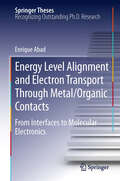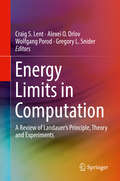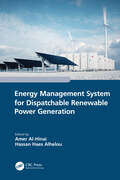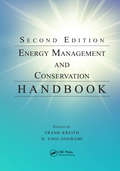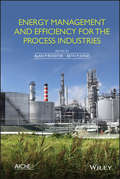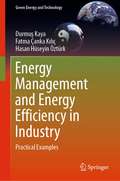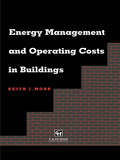- Table View
- List View
Energy Harvesting Trends for Low Power Compact Electronic Devices (EAI/Springer Innovations in Communication and Computing)
by Chandan Kumar Maheswar Rajagopal Anveshkumar Nella Anirban BhowmickThis book focuses on the numerous energy harvesting techniques and their system implementation towards the fulfilment of energy requirements in compact electronic devices. These cover a wide range of applications in portable devices, bio-medical services, agriculture needs, mechanical systems, sensor networks, automobiles, food sector, home appliances, industry needs, etc. The authors detail energy harvesting methods using the latest technologies in acoustics, bio-chemical, thermal, artificial light, fluid flow, vibrations, EM energy, RF energy, piezoelectric, electrostatic, photovoltaic, thermoelectric, hybrid harvesting, ultrasonic, infrared, light, wind, and solar. The book is intended for researchers, academics, professionals, and students in energy harvesting.
Energy Harvesting Wireless Communications (Wiley - IEEE)
by Shuguang Cui Sheng Zhou Zhisheng Niu Jie Xu Chuang Huang Rui ZhangEnergy Harvesting Wireless Communications offers a review of the most current research as well as the basic concepts, key ideas and powerful tools of energy harvesting wireless communications. Energy harvesting is both renewable and cheap and has the potential for many applications in future wireless communication systems to power transceivers by utilizing environmental energy such as solar, thermal, wind, and kinetic energy. The authors—noted experts in the field—explore the power allocation for point-to-point energy harvesting channels, power allocation for multi-node energy harvesting channels, and cross-layer design for energy harvesting links. In addition, they offer an in-depth examination of energy harvesting network optimization and cover topics such as energy harvesting ad hoc networks, cost aware design for energy harvesting assisted cellular networks, and energy harvesting in next generation cellular networks.
Energy Harvesting and Energy Efficiency
by Frede Blaabjerg Nicu Bizon Naser Mahdavi Tabatabaei Erol KurtThis book presents basic and advanced concepts for energy harvesting and energy efficiency, as well as related technologies, methods, and their applications. The book provides up-to-date knowledge and discusses the state-of-the-art equipment and methods used for energy harvesting and energy efficiency, combining theory and practical applications. Containing over 200 illustrations and problems and solutions, the book begins with overview chapters on the status quo in this field. Subsequent chapters introduce readers to advanced concepts and methods. In turn, the final part of the book is dedicated to technical strategies, efficient methods and applications in the field of energy efficiency, which also makes it of interest to technicians in industry. The book tackles problems commonly encountered using basic methods of energy harvesting and energy efficiency, and proposes advanced methods to resolve these issues. All the methods proposed have been validated through simulation and experimental results. These "hot topics" will continue to be of interest to scientists and engineers in future decades and will provide challenges to researchers around the globe as issues of climate change and changing energy policies become more pressing. Here, readers will find all the basic and advanced concepts they need. As such, it offers a valuable, comprehensive guide for all students and practicing engineers who wishing to learn about and work in these fields.
Energy Harvesting and Storage Devices: Sustainable Materials and Methods
by Laxman Raju Thoutam J Ajayan D NirmalThe book discusses the materials, devices, and methodologies that can be used for energy harvesting including advanced materials, devices, and systems. It describes synthesis and fabrication details of energy storage materials. It explains use of high-energy density thin films for future power systems, flexible and biodegradable energy storage devices, fuel cells and supercapacitors, nanogenerators for self-powered systems, and innovative energy harvesting methodologies. Features: Covers all relevant topics in energy harvesting research and focuses on the current state-of-the-art techniques and materials for this application. Showcases the true potential of the nature in energy harvesting industry by discussing various harvesting mechanisms based on renewable and sustainable energy sources. Explains the recent trends in flexible and wearable energy storage devices that are currently being used in IoT-based smart devices. Overviews of the state-of-the-art research performed on design and development of energy harvesting devices. Highlights the interdisciplinary research efforts needed in energy harvesting and storage devices to transform conceptual ideas to working prototypes. This book is aimed at graduate students and researchers in emerging materials, energy engineering, including harvesting and storage.
Energy Harvesting and Storage: Fundamentals and Materials (Energy Systems in Electrical Engineering)
by M. K. Jayaraj Aldrin Antony P. P. SubhaThis book covers recent technologies developed for energy harvesting as well as energy storage applications. The book includes the fabrication of optoelectronic devices such as high-efficiency c-Si solar cells, carrier selective c-Si solar cells, quantum dot, and dye-sensitized solar cells, perovskite solar cells, Li-ion batteries, and supercapacitors. Aiming at beginners in the respective areas, the basic principles and mechanism of the optoelectronic phenomena behind every application are detailed in the book. The book offers schematics, tables, graphical representations, and illustrations to enable better understanding. Among the nine chapters, the first four chapters are dedicated to various types of high-efficiency solar cells and the remaining chapters discuss the methods for energy storage such as the fabrication of batteries and supercapacitors. The book is a useful reference for active researchers and academicians working in energy harvesting and energy storage areas.
Energy Harvesting for Wearable Sensor Systems: Inductive Architectures for the Swing Excitation of the Leg (Springer Series in Advanced Microelectronics #62)
by Yiannos Manoli Klevis YlliThis book investigates several non-resonant inductive harvester architectures in order to find the magnet coil arrangement that generates the largest power output. The book is useful as a step-by-step guide for readers unfamiliar with this form of energy harvesting, but who want to build their own system models to calculate the magnet motion and, from that, the power generation available for body-worn sensor systems. The detailed description of system model development will greatly facilitate experimental work with the aim of fabricating the design with the highest predicted power output. Based on the simulated optimal geometry, fabricated devices achieve an average power output of up to 43 mW during walking, an amount of power that can supply modern low-power, body-worn systems. Experiments were also carried out in industrial applications with power outputs up to 15 mW. In sum, researchers and engineers will find a step-by-step introduction to inductive harvesting and its modeling aspects for achieving optimal harvester designs in an efficient manner.
Energy Harvesting with Functional Materials and Microsystems (Devices, Circuits, and Systems #23)
by Krzysztof Iniewski Madhu Bhaskaran Sharath SriramFor decades, people have searched for ways to harvest energy from natural sources. Lately, a desire to address the issue of global warming and climate change has popularized solar or photovoltaic technology, while piezoelectric technology is being developed to power handheld devices without batteries, and thermoelectric technology is being explored to convert wasted heat, such as in automobile engine combustion, into electricity. Featuring contributions from international researchers in both academics and industry, Energy Harvesting with Functional Materials and Microsystems explains the growing field of energy harvesting from a materials and device perspective, with resulting technologies capable of enabling low-power implantable sensors or a large-scale electrical grid. In addition to the design, implementation, and components of energy-efficient electronics, the book covers current advances in energy-harvesting materials and technology, including: High-efficiency solar technologies with lower cost than existing silicon-based photovoltaics Novel piezoelectric technologies utilizing mechanical energy from vibrations and pressure The ability to harness thermal energy and temperature profiles with thermoelectric materials Whether you’re a practicing engineer, academician, graduate student, or entrepreneur looking to invest in energy-harvesting devices, this book is your complete guide to fundamental materials and applied microsystems for energy harvesting.
Energy Harvesting: Enabling IoT Transformations (Chapman & Hall/CRC Internet of Things)
by Shabana Urooj Deepti Agarwal Kimmi VermaEnergy Harvesting: Enabling IoT Transformations gives insight into the emergence of energy harvesting technology and its integration with IoT-based applications. The book educates the reader on how energy is harvested from different sources, increasing the effectiveness, efficiency and lifetime of IoT devices. • Discusses the technology and practices involved in energy harvesting for biomedical, agriculture and automobile industries • Compares the performance of IoT-based devices with and without energy harvesting for different applications • Studies the challenges and issues in the implementation of EH-IoT • Includes case studies on energy-harvesting approach for solar, thermal and RF sources • Analyzes the market and business opportunities for entrepreneurs in the field of EH-IoT. This book is primarily aimed at graduates and research scholars in wireless sensor networks. Scientists and R&D workers in industry will also find this book useful.
Energy Harvesting: Solar, Wind, and Ocean Energy Conversion Systems (Energy, Power Electronics, and Machines)
by Alireza Khaligh Omer C. OnarAlso called energy scavenging, energy harvesting captures, stores, and uses "clean" energy sources by employing interfaces, storage devices, and other units. Unlike conventional electric power generation systems, renewable energy harvesting does not use fossil fuels and the generation units can be decentralized, thereby significantly reducing transmission and distribution losses. But advanced technical methods must be developed to increase the efficiency of devices in harvesting energy from environmentally friendly, "green" resources and converting them into electrical energy. Recognizing this need, Energy Harvesting: Solar, Wind, and Ocean Energy Conversion Systems describes various energy harvesting technologies, different topologies, and many types of power electronic interfaces for stand-alone utilization or grid connection of energy harvesting applications. Along with providing all the necessary concepts and theoretical background, the authors develop simulation models throughout the text to build a practical understanding of system analysis and modeling. With a focus on solar energy, the first chapter discusses the I−V characteristics of photovoltaic (PV) systems, PV models and equivalent circuits, sun tracking systems, maximum power point tracking systems, shading effects, and power electronic interfaces for grid-connected and stand-alone PV systems. It also presents sizing criteria for applications and modern solar energy applications, including residential, vehicular, naval, and space applications. The next chapter reviews different types of wind turbines and electrical machines as well as various power electronic interfaces. After explaining the energy generation technologies, optimal operation principles, and possible utilization techniques of ocean tidal energy harvesting, the book explores near- and offshore approaches for harvesting the kinetic and potential energy of ocean waves. It also describes the required absorber, turbine, and generator types, along with the power electronic interfaces for grid connection and commercialized ocean wave energy conversion applications. The final chapter deals with closed, open, and hybrid-cycle ocean thermal energy conversion systems.
Energy Harvesting: Technologies, Systems, and Challenges (EuMA High Frequency Technologies Series)
by Apostolos Georgiadis Ana Collado Manos M. TentzerisA thorough treatment of energy harvesting technologies, highlighting radio frequency (RF) and hybrid-multiple technology harvesting. The authors explain the principles of solar, thermal, kinetic, and electromagnetic energy harvesting, address design challenges, and describe applications. The volume features an introduction to switched mode power converters and energy storage and summarizes the challenges of different system implementations, from wireless transceivers to backscatter communication systems and ambient backscattering. This practical resource is essential for researchers and graduate students in the field of communications and sensor technology, in addition to practitioners working in these fields.
Energy Humanities. Current State and Future Directions
by Matúš Mišík Nada KujundžićThis edited book explicitly deals with the energy humanities, summarising existing knowledge in the area and outlining possible future directions for the nascent field. Assuming a variety of disciplinary stances and using a plethora of methodologies to address a number of pressing energy-related issues, the individual contributions showcase the crucial importance of including the humanities and social sciences into the current discussion on energy. Furthermore, they illustrate one of the central claims of the energy humanities, namely, that energy permeates all aspects of our contemporary modes of existence, and is inextricably linked with historical, political, social, ideological, and cultural issues, relationships, and practices.Through numerous case studies, Energy Humanities and Energy Transition looks to the past, present, and future in search of examples of best practices and possible models for pathways to a successful energy transition and life ‘after oilʼ. While much of existing research on energy humanities has been criticised for its excessive focus on oil, this book considers a wide range of energy resources, including nuclear energy, renewables, and natural gas. Furthermore, it brings to the forefront under-researched topics such as the colonial legacy inscribed in energy infrastructure and the energy history of the humanities. The contributions in this volume explore not only how the perspectives and expertise of the humanities and social sciences can alter the discourse on energy transition, and our way of thinking about possible solutions and future scenarios, but also how their new focus on energy affects the disciplines themselves.Energy Humanities and Energy Transition presents a variety of theories, methods, topics, and disciplinary angles, meaning it will be of interest to a wide audience, from practitioners and policy makers, to students and researchers working across the humanities and social sciences. The thematically oriented structure, distinct focus of each individual chapter, and the comprehensive introduction and conclusion that contextualize the contributions within the wider framework of energy transition, make this edited book accessible to readers from many different fields and suitable for various university programs.
Energy Informatics
by Sebastian Gottwalt Lukas König Hartmut SchmeckThis book constitutes the refereed proceedings of the 4th D-A-CH Conference on Energy Informatics, D-A-CH EI 2015, held in Karlsruhe, Germany, in November 2015. The 18 revised full papers presented were carefully reviewed and selected from 36 submissions. The papers are organized in topical sections on distributed energy sources and storage, smart meters and monitoring, research lab infrastructures, electric mobility, communication and security, and modeling and simulation.
Energy Intermittency
by Bent SorensenThe first book to consider intermittency as a key point of an energy system, Energy Intermittency describes different levels of variability for traditional and renewable energy sources, presenting detailed solutions for handling energy intermittency through trade, collaboration, demand management, and active energy storage. Addressing energy supply intermittency systematically, this practical text: Analyzes typical time-distributions and intervals between episodes of demand-supply mismatch and explores their dependence on system layouts and energy source characteristics Simulates scenarios regarding resource time-flow, energy conversion devices, and demand structure to assist in evaluating the technical viability of the proposed solutions Discusses the conditions for establishing such systems in terms of economic requirements and regulatory measures In one concise and convenient volume, Energy Intermittency provides a comprehensive overview of all the causes and remedies of energy supply intermittency.
Energy Internet and We-Energy (Renewable Energy Sources & Energy Storage)
by Qiuye SunThis book focuses on the framework and implementation of energy integration systems with energy and smart-control technologies. It describes in detail We-Energy, a novel energy interaction mode based on a cyber-physical-economy-energy model, which can be adopted to solve the problem of energy supply and utilization. It then analyzes the key devices and technologies for developing the Energy Internet, such as converters, energy-conversion devices, system-level connection devices, optimization control strategies, cyber-physical system security, energy-system stability, communication technologies’ operating modes and distributed optimization algorithms, to enable readers to gain a comprehensive understanding of the topic. Lastly, it offers an outlook on the development of the Energy Internet, providing a reference for cross-integration between different disciplines.The book is an indispensable resource for power enterprises, manufacturers in the power-supply industry, and researchers in the field of Energy Internet application. It is also useful for university and college teachers and students seeking to deepen their understanding of the Energy Internet, as well as for readers interested in the Energy Internet correlation techniques.
Energy Internet: Systems and Applications
by Ahmed F Zobaa Junwei CaoThis textbook is the first of its kind to comprehensively describe the energy Internet, a vast network that efficiently supplies electricity to anyone anywhere and is an internet based wide area network for information and energy fusion. The chapters are organized into five parts: Architecture and Design, Energy Switching and Routing, Information and Communication, Energy Management Systems and Energy Market and Trading, and capture the spectrum of this exponential transformation, while also presenting the plethora of open problems that this transformation poses for researchers from mixed academic backgrounds. The scope includes key technologies on distributed energy sources, microgrids, energy storage, solar and wind energy, power grid, smart grid, power quality, power electronics, data centers, distributed computing and networking, cloud computing and big data, and software-defined networking. The book presents the basic principles of energy internet and emphasizes the current research trends in the field of energy Internet at an advanced level. It includes instructor materials, case-studies, and worked examples throughout. This is an ideal resource for students in advanced graduate-level courses and special topics in energy, information and control systems, and is a useful tool for utility engineers who seek an intuitive understanding of the emerging applications of energy Internet.
Energy Island: How One Community Harnessed the Wind and Changed Their World
by Allan DrummondEnergy Island is a true inspiring story of a small island in Denmark that became completely energy independent, primarily by using wind energy.
Energy Issues and Transition to a Low Carbon Economy: Insights from Mexico (Strategies for Sustainability)
by Arturo Molina Francisco J. Lozano Alberto MendozaWithout energy, there is no well-functioning economy, besides facing social risks. This book provides a systemic approach to energy in Mexico and its relations to the USA arising from the energy reform of the former. It covers the transition from fossil fuels to a low-carbon economy, relying heavily on renewable sources and mitigating climate change risks. Several human knowledge disciplines and topics are covered in the book, including public policy, economics, transboundary issues, electricity and thermal energy, residual biomass use, distributed energy systems and its management, and decision-making tools. An analysis is considered regarding energy issues interaction in the Mexican-USA border, which differ in both countries from pricing and policy, and the work and research that has been developed for transboundary energy trade.
Energy Justice Across Borders
by Gunter Bombaerts Kirsten Jenkins Yekeen A. Sanusi Wang GuoyuThis book is open access under a CC BY 4.0 license.We must find new and innovative ways of conceptualizing transboundary energy issues, of embedding concerns of ethics or justice into energy policy, and of operationalizing response to them. This book stems from the emergent gap; the need for comparative approaches to energy justice, and for those that consider ethical traditions that go beyond the classical Western approach. This edited volume unites the fields of energy justice and comparative philosophy to provide an overarching global perspective and approach to applying energy ethics. We contribute to this purpose in four sections: setting the scene, practice, applying theory to practice, and theoretical approaches. Through the chapters featured in the volume, we position the book as one that contributes to energy justice scholarship across borders of nations, borders of ways of thinking and borders of disciplines. The outcome will be of interest to undergraduate and graduate students studying energy justice, ethics and environment, as well as energy scholars, policy makers, and energy analysts.
Energy Level Alignment and Electron Transport Through Metal/Organic Contacts
by Enrique AbadIn recent years, ever more electronic devices have started to exploit the advantages of organic semiconductors. The work reported in this thesis focuses on analyzing theoretically the energy level alignment of different metal/organic interfaces, necessary to tailor devices with good performance. Traditional methods based on density functional theory (DFT), are not appropriate for analyzing them because they underestimate the organic energy gap and fail to correctly describe the van der Waals forces. Since the size of these systems prohibits the use of more accurate methods, corrections to those DFT drawbacks are desirable. In this work a combination of a standard DFT calculation with the inclusion of the charging energy (U) of the molecule, calculated from first principles, is presented. Regarding the dispersion forces, incorrect long range interaction is substituted by a van der Waals potential. With these corrections, the C60, benzene, pentacene, TTF and TCNQ/Au(111) interfaces are analyzed, both for single molecules and for a monolayer. The results validate the induced density of interface states model.
Energy Limits in Computation: A Review of Landauer’s Principle, Theory and Experiments
by Wolfgang Porod Craig S. Lent Alexei O. Orlov Gregory L. SniderThis book is a single-source reference to the issues involved in the Landauer principle, which has gained new prominence recently, due to the large amount of heat generated by today’s computers. If Landauer’s principle is correct, there may be ways to build computers that dissipate far less power (corresponding to heat generated) than today’s computers. This book brings together all sides of the discussions regarding Landauer’s principle, both theoretical and experimental, empowering readers to gain better understanding of dissipation in computation, and the limits if any to progress in computation related to energy dissipation. It represents the best and most thorough examination of the important issue of Landauer’s principle that is available in one volume.Provides an in-depth investigation of the Landauer principle and how it relates to the possible existence of lower bounds on dissipation in computation;Gathers together both sides of the discussion: those who agree with Landauer and his conclusions, and those who think that Landauer was not correct, offering fresh perspective on the issues in the new light of experiments;Offers insight into the future of silicon CMOS and the limits if any to progress in computation related to energy dissipation.
Energy Management System for Dispatchable Renewable Power Generation
by Hassan Haes Alhelou Amer Al-HinaiEnhancing the integration of renewable power generation from wind and solar into the traditional power network requires the mitigation of the vulnerabilities affecting the grid as a result of the intermittent nature of these resources. Variability and ramp events in power output are the key challenges to the system operators due to their impact on system balancing, reserves management, scheduling, and commitment of generation units. This book presents development of energy management system for renewable power generation (EMSRPG) tool that aims to achieve power-dispatching strategies based on forecasting renewable energy resources outputs to guarantee optimal dispatch of hybrid wind-solar photovoltaic power systems (HWSPS). The key selling points of the book include the following: Renewable energy management in modern and future smart power systems Energy management systems Modeling and simulations using a real-time digital simulator (RTDS) High penetration level of renewable energy sources Case studies based on Oman’s power systems and other power grids This book discusses the challenges of integrating renewable resources, including low inertia systems, hosting capacity limitations of existing power systems, and weak grids. It further examines the detailed topologies, operation principles, recent developments in control techniques, and stability of power systems with a large scale of renewables. Finally, it presents case studies of recent projects from around the world where dispatchable power plant techniques are used to enhance power system operation.
Energy Management and Conservation Handbook (Mechanical and Aerospace Engineering Series)
by Frank Kreith and D. Yogi GoswamiEnergy is the mainstay of industrial societies, and without an adequate supply of energy the social, political and economic stability of nations is put into jeopardy. With supplies of inexpensive fossil fuels decreasing, and climate change factors becoming more threatening, the need to conserve energy and move steadily to more sustainable energy sources is more urgent than ever before. The updated Second Edition of this successful handbook includes chapters from leading experts on the economics and fiscal management of energy, with a focus on the tools available to advance efficiency and conservation measures. Updated coverage of renewable energy sources, energy storage technologies, energy audits for buildings and building systems, and demand-side management is provided. The appendix of the handbook provides extensive data resources for analysis and calculation.
Energy Management and Efficiency for the Process Industries
by Beth P. Jones Alan P. RossiterProvides a unique overview of energy management for the process industries Provides an overall approach to energy management and places the technical issues that drive energy efficiency in context Combines the perspectives of freewheeling consultants and corporate insiders In two sections, the book provides the organizational framework (Section 1) within which the technical aspects of energy management, described in Section 2, can be most effectively executed Includes success stories from three very different companies that have achieved excellence in their energy management efforts Covers energy management, including the role of the energy manager, designing and implementing energy management programs, energy benchmarking, reporting, and energy management systems Technical topics cover efficiency improvement opportunities in a wide range of utility systems and process equipment types, as well as techniques to improve process design and operation
Energy Management and Energy Efficiency in Industry: Practical Examples (Green Energy and Technology)
by Durmuş Kaya Fatma Çanka Kılıç Hasan Hüseyin ÖztürkThis book is presented to demonstrate how energy efficiency can be achieved in existing systems or in the design of a new system, as well as a guide for energy savings opportunities. Accordingly, the content of the book has been enriched with many examples applied in the industry. Thus, it is aimed to provide energy savings by successfully managing the energy in the readers’ own businesses. The authors primarily present the necessary measurement techniques and measurement tools to be used for energy saving, as well as how to evaluate the methods that can be used for improvements in systems. The book also provides information on how to calculate the investments to be made for these necessary improvements and the payback periods. The book covers topics such as: • Reducing unit production costs by ensuring the reduction of energy costs, • Efficient and quality energy use, • Meeting market needs while maintaining competitive conditions, • Ensuring the protection of the environment by reducing CO2 and CO emissions with energy saving and energy efficiency, • Ensuring the correct usage of systems by carrying out energy audits. In summary, this book explains how to effectively design energy systems and manage energy to increase energy savings. In addition, the study has been strengthened by giving some case studies and their results in the fields of intensive energy consumption in industry. This book is an ideal resource for practitioners, engineers, researchers, academics, employees and investors in the fields of energy, energy management, energy efficiency and energy saving.
Energy Management and Operating Costs in Buildings
by Keith MossManaging the consumption and conservation of energy in buildings must now become the concern of both building managers and occupants. The provision of lighting, hot water supply, communications, cooking, space heating and cooling accounts for 45 per cent of UK energy consumption.Energy Management and Operating Costs in Buildings introduces the reader to the principles of managing and conserving energy consumpton in buildings people use for work or leisure. Energy consumption is considered for the provision of space heating, hot water, supply ventilation and air conditioning. The author introduces the use of standard performance indicators and energy consumption yardsticks, and discusses the use and application of degree days.
